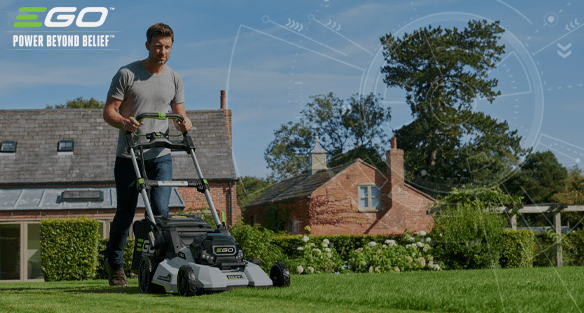1. Tidying up after autumn and winter
You’ll need:
- Garden rake or cordless leaf blower
- Wheelbarrow or garden sacks (compostable, biodegradable)
Have a walk around your lawn. Hard objects in the grass could damage your lawn mower or dull the blades. They could also be thrown by the blades, causing damage to other objects in the vicinity, or even cause injury to yourself or someone else.
Grass doesn’t grow when the ground temperature is under about 5 degrees Celsius. If your last cut of the season was in September or October, your lawn won’t have grown long enough to hide stones, sticks or broken tree branches - even pet toys, so you should be able to find anything that the wind, your children or your pets have discarded.
Next, tackle soft matter that has been scattered. If you’re ready for physical work, a traditional garden rake is your tool of choice. For medium-sized to large areas, a cordless leaf blower is ideal. A powerful leaf blower will make light work of leaves and detritus on your lawn (and your paths and driveways); one with a boost function will help shift damp leaves, even in frosty conditions.
Whichever way you do it, scoop them up and mulch them into your compost heap or arrange for the council to collect.
2. Feeding, weeding and de-mossing
If weeds or crabgrass (Digitaria) have taken hold, this is your opportunity to get rid of them. This informative piece in Good Housekeeping details non-chemical ways to get rid of crabgrass, which is an annoying eyesore for those of us that like a smooth, flawless finish.
January-February is the ideal time to give your lawn a good feed before you start up your cordless lawn mower. We recommend using organic lawn feed or fertiliser that has natural ingredients.
Some products will also help you get rid of moss. A little moss - as well as clover - might not be a bad thing though - they can help keep nutrients and moisture in your lawn.
3. How to know your lawn is ready for the first cut
Don’t let your grass grow too long in the spring - but don’t give it a first cut too soon either. Keep an eye on it and growth will become unmistakable.
The first cut of the year should be cautious - cut too low, too soon, and you risk introducing weeds or disease. Set your battery lawn mower to its highest cutting point for the first mow of the year (our cordless lawn mowers have a six-position spring-loaded deck height adjustment, up to 28cm).
You can gradually decrease the cutting point over the next few weeks. Mowing your lawn every two weeks will probably be fine until the end of April; when the warm weather hits, you’ll be mowing every week until the end of September to keep it looking great.

4. Preparing your mower
We recommend annual servicing through a certified service centre - in the quiet months is an ideal time to get this done.
If your cordless lawn mower is not quite ready for its service, give it a thorough checking over before you use it for the first cut of the year. Some parts are subject to wear and tear and might need replacing.
On an EGO battery-powered mower, this includes:
- Grass bag components
- Discharge cover
- Side discharge chute
- Mulching insert
- Trailing shield
We also recommend checking:
- All nuts and bolts are tight, including motor mounting bolts and blade bolts
- The blade is clean, sharp and undamaged (wear protective gloves while handling)
- Safety devices and cords are undamaged and have not been tampered with
- Your cordless mower battery is fully charged
Refer to the original manual for full details. Worn or damaged parts should be replaced with identical replacement parts (see your manual) by a qualified engineer. Contact EGO Customer Service or find your closest EGO dealer for more details.
